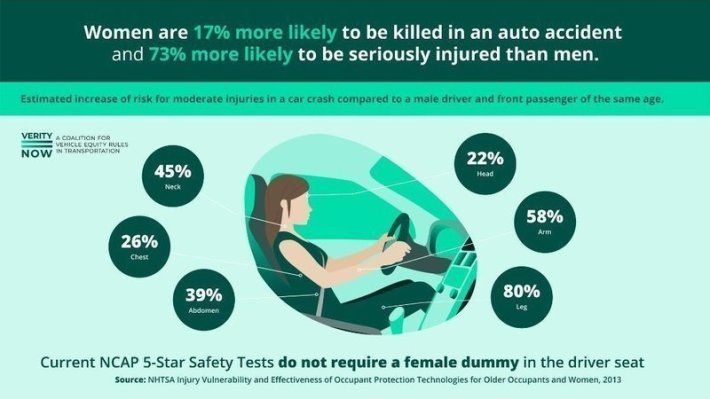
Simple reforms to federal testing standards could end horrific disparities in car crash deaths between the sexes — and the impending enactment of the new infrastructure bill is the perfect time to implement them, a new coalition says.
In a letter to US DOT Secretary Pete Buttigieg, advocates from Vehicle Equity Rules in Transportation (also known as Verity Now) urged federal regulators to update Federal Motor Vehicle Safety Standards and the New Car Assessment Program to require the use of "biofidelic" crash test dummies that better simulate the effects of vehicle impacts on the bodies of cisgender women and non-binary people who were assigned female at birth. They also want the agency to make a commitment to regularly review those standards and update them as the average height, weight and physiology of the sexes change over time, and to implement the latest crash testing technology as it improves.
Those might seem like small shifts, but the coalition says they could save up to 1,342 lives every single year. Studies show that when they're inside of a car at the time of a crash, women and people who were assigned female at birth are 17 percent more likely to die and 73 percent more likely to be seriously injured than a driver or passenger who was assigned male at birth who's struck in the same conditions. That's thanks, in part, to the fact that most crash test dummies are designed to mimic the body proportions and internal physiology of bodies typically characterized as male — and despite being made aware of the problem decades ago, regulators have failed to update their approach.
"I can just not, for the life of me, believe this is still happening in the United States," said Susan Molinari, a former member of Congress from New York and Verity Now co-chair. "But I guess we shouldn’t be surprised; women have been left out of all kinds of testing and clinical trials for decades, and this isn’t any different."

There's less research on how likely people of various genders are to survive car crashes when they're not inside a vehicle — probably because until recently, federal regulators haven't been required to test how well vulnerable road users fare in vehicle collisions at all, leaving the private sector little incentive to do so, either.
Under the recently passed Infrastructure Investment and Jobs Act, the regulators who supervise the New Car Assessment Program will, for the first time, be required to test and provide information to prospective car-buyers on how likely their vehicle is to kill or injure a pedestrian, a critical standard that other nations adopted way back in 2008.
Unfortunately, that won't actually prevent cars that fail such tests from being sold, the way an update to Federal Motor Vehicle Safety Standards would — and it won't address the larger reasons behind gender disparities in crash deaths, either. Studies have shown that male-identified pedestrians are twice as likely to die from injuries sustained in car crashes than females, but researchers speculate that has more to do with the fact that men are more likely to walk in dangerous environments, like attempting mid-block crossings on high-speed arterials, than their physiology. (No one has comprehensively studied how like pedestrians of different genders are to survive when struck by similar cars traveling at similar speeds on similarly designed roads, though as SUVs continue to dominate U.S. roads, it's worth noting that the height of the average bumper is quickly rising towards the head and neck level of the average American female-identified person, who is typically shorter than the average male.)
Some researchers have questioned whether behavioral and environmental factors might help explain sex disparities among car occupants involved in crashes, too; a recent Insurance Institute for Highway Safety study found that men are more likely than other genders both to drive aggressively, and to buy SUVs, trucks, and large cars that are typically more deadly to the occupants of smaller cars they strike.
But few doubt that sexist vehicle testing standards are a major contributor to the problem, or that crash testing standards desperately need to be fixed.
"A woman [or person assigned female at birth] is not a little man," added Molinari. "Our necks are less muscular, so we experience more whiplash than men [and assigned females at birth]. Women sit closer to the steering wheel; our abdomen muscles are built differently and respond differently when they're hit; our spines have less muscle. There are just so many differences in the impact that a crash has on our bodies, and we should not be afraid to recognize those differences and compensate for those differences."
With the new car assessment program set for a pedestrian-friendly overhaul anyway, advocates say it's the perfect time to correct all the inequities embedded in the program — and in every program under the U.S. DOT's purview, including the motor vehicle safety standards.
"NHTSA can do this tomorrow," said Molinari. "And if they don’t, we’ll go the congressional route and get legislation that mandates that they do. There are real people behind the statistics, and making them wait 40 years without updating this regulation is ridiculous. We've waited long enough."






